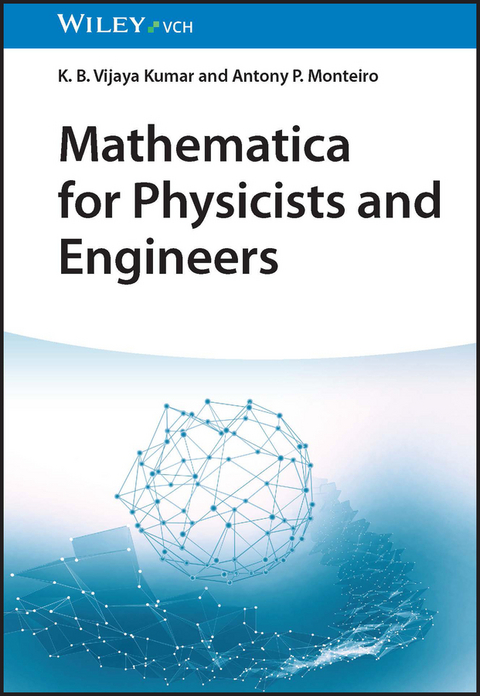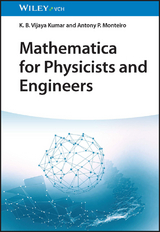Mathematica for Physicists and Engineers
Wiley-VCH (Verlag)
978-3-527-41424-6 (ISBN)
The textbook explains, in a highly practical manner, the use of the powerful computer algebra system Mathematica for solving real-life problems in physics and engineering.
- Schneller Einstieg in Mathematica: Das Werk bietet eine kompakte Einführung in die wichtigsten Funktionen und Eigenarten von Mathematica für Studierende der Bereiche Physik und Ingenieurwesen Verbindung von Mathematik und Anwendung: Es werden zahlreiche Arbeitsbeispiele dargestellt und mit Zahlen illustriert, die von Studierenden in den Kursen erprobt wurdenFestigung des Verständnisses der grundlegenden Themen: Bei den Arbeitsbeispielen handelt es sich um Übungen aus Standardlehrbüchern für Physik, Mathematik und IngenieurwesenEinzigartiges Themenangebot: Es werden zahlreiche selten behandelte Fragestellungen im Zusammenhang mit Vektoren, Matrizen, Laplace-Transformationen, Fourier-Transformationen, Dirac-Delta-Funktionen und aus der Quantenmechanik betrachtet
Mathematica is arguably the most powerful computer algebra system for computing symbolic and numerical solutions to even the most challenging equations in all fields of the natural sciences. However, the sheer breadth of the available commands, the intricacies of the programming language and even the user interface can be overwhelming for physics and engineering students who want to work on relatively simple problems in their areas of study.
This is why numerous universities across the world offer dedicated courses on how to successfully use Mathematica for the solution of introductory and advanced problems in physics and engineering.
The textbook starts out by giving a gentle introdution to Mathematica, its nomenclature and its programming language before addressing various possibilities for graphic output and the foundation for understanding the more advanced topics, namely, the methods of solving real, complex and matrix equations and systems of equations.
It continues with differential and integral calculus in one and more dimensions and also covers dealing with the powerful, but elusive Dirac Delta function. The following chapters deal with the Fourier and Laplace transform, two integral transformations that are instrumental in many fields of physics and engineering for the solution of ordinary and partial differential equations.
Vector calculus, the mathematical core of electrodynamics, is covered next, and the book concludes with solving quantum mechanical problems in infinite-dimensional linear vector spaces.
K. B. Vijaya Kumar is a professor of physics in the Department of Physics at the N.M.A.M Institute of Technology, Nitte, India. His research is focused on theoretical and computational nuclear and particle physics. Prof. K. B. Vijaya Kumar was a Commonwealth Academic Staff fellow (1998-1999), a World Academy of Sciences-UNESCO fellow at the Institute of Theoretical Physics, Beijing (2003-2006), and visiting scientist at the Research Center Jülich, Germany (2005) and at the Institute for Theoretical Physics, University of Tübingen, Germany (2006- 2009).
Dr. Antony Prakash Monteiro is working in the Department of Physics at St. Philomena College, Puttur, India. He has more than thirteen years of teaching experience at undergraduate and postgraduate levels and has authored several books in various fields of physics. He is the recipient of the Vision Group on Science and Technology Award for Research Publications 2017-18 for his high-impact research publications. His research interest is aimed at computational and theoretical nuclear and particle physics.
CHAPTER 1 - Preliminary Notions
1.1 Introduction
1.2 Versions of Mathematica
1.3 Getting Started
1.4 Simple Calculations
1.4.1 Arithmetic Operations
1.4.2 Approximate Numerical Results
1.4.3 Algebraic Calculations
1.4.4 Defining Variables
1.4.5 Using the Previous Results
1.4.6 Suppressing the Output
1.4.7 Sequence of Operations
1.5 Built-in Functions
1.6 Additional Features
1.6.1 Arbitrary-Precision Calculations
1.6.2 Value of Symbols
1.6.3 Defining, Naming and Evaluating Functions
1.6.4 Composition of Functions
1.6.5 Conditional Assignment
1.6.6 Warnings and Messages
1.6.7 Interrupting Calculations
1.6.8 Using Symbols to Tag Objects
CHAPTER 2 - Basic Mathematical Operations
2.1 Introduction
2.2 Basic Algebraic Operations
2.3 Basic Trigonometric Operations
2.4 Basic Operations with Complex Numbers
CHAPTER 3 - Lists and Tables
3.1 Lists
3.2 Arrays
3.3 Tables
3.4 Extracting the Elements from the Array/Tables
CHAPTER 4 - Two-Dimensional Graphics
4.1 Introduction
4.2 Plotting Functions of a Single Variable
4.3 Additional Commands
4.4 Plot Styles
4.5 Probability Distribution
4.5.1 Binomial Distribution
4.5.2 Poisson Distribution
4.5.3 Normal or Gaussian Distribution
CHAPTER 5 - Parametric, Polar, Contour, Density and List Plots
5.1 Introduction
5.2 Parametric plotting
5.3 Polar Plots
5.3.1 Polar Plots of Circles
5.3.2 Polar Plots of Ellipses, Parabola and Hyperbola
5.4 Implicit Plots
5.5 Contour Plots
5.6 Density Plots
5.7 List Plots
5.8 LogPlot, LogLogPlot, ErrorListPlot
5.9 Least Square Fit
CHAPTER 6 - Three-Dimensional Graphics
6.1 Introduction
6.2 Plotting The Functions of Two Variables
6.3 Parametric Plots
6.4 3D Plots in Cylindrical and Spherical Coordinates
6.5 ContourPlot3D
6.6 ListContourPlot3D
6.7 ListSurfacePlot3D
6.8 Surface of Revolution
CHAPTER 7 - Matrices
7.1 Introduction
7.2 Properties of Matrices
7.3 Types of Matrices
7.4 The Rank of the Matrix
7.5 Special Matrices
7.6 Creation of the Matrix
7.6.1 Extraction of the Sub Matrices or the Elements of the Matrices
7.7 Properties of the Special Matrices
7.8 The Direct Sum of Matrices
7.9 The Direct Product of Matrices
7.10 Examples from Group Theory
7.10.1 SO(3) Group
7.10.2 SU(n) Group
7.10.3 SU(2) Group
7.10.4 SU(3) Group
CHAPTER 8 - Solving Algebraic and Transcendental Equations
8.1 Solving Systems of Linear Equations
8.1.1 Number of Equations Equal to the Number of Unknowns
8.1.2 Number of Equations Less Than the Number of Unknowns
8.1.3 Number of Equations More Than the Number of Unknowns
8.2 Non- Linear Algebraic Equations
8.3 Solving Transcendental Equations
CHAPTER 9 - Eigenvalues and Eigenvectors of a Matrix: Matrix Diagonalization
9.1 Introduction
9.2 Eigenvalues and Vectors of a Matrix
9.2.1 Distinct Eigenvalues having Independent Eigenvectors
9.2.2 Multiple Eigenvalues having Independent Eigenvectors
9.2.3 Multiple Eigenvalues not having Independent Eigenvectors
9.3 The Cayley-Hamilton Theorem
9.4 Diagonalization of a Matrix
9.4.1 Gram-Schmidt Orthogonalization Method
9.4.2 Diagonalizability of a Matrix
9.4.3 Case of a Non-diagonalizable Matrix
9.5 Some More Properties of Special Matrices
9.6 Power of a Matrix
9.6.1 Roots of a Matrix
9.6.2 Exponential of a Matrix
9.6.3 Logarithm of a Matrix
9.7 Power of a Matrix by Diagonalization
9.8 Bilinear, Quadratic and Hermitian Forms
9.9 Principal Axes Transformation
CHAPTER 10 - Differential Calculus
10.1 Introduction
10.2 Limits
10.2.1 Evaluation of the Limits Using L' Hospital?s Rule
10.2.2 Application of L' Hospital?s Rule for "Indeterminate Form
10.2.3 Evaluation of the Limit Using Taylor's Theorem of Mean
10.3 Differentiation
10.3.1 Computation of Partial Derivatives
10.3.2 Total Derivative
10.4 Derivatives of Functions in Parametric Forms
10.4.1 Chain Rule for a Function of Two Independent Variables
10.4.2 Chain Rule for a Function of Three Independent Variables
10.5 Rolle's Theorem
10.6 Mean Value Theorem
10.7 Series
10.8 Maxima and Minima
10.8.1 First Derivative Test
10.8.2 Second Derivative Test
10.8.3 Maximum and Minimum Values of a Function in a Closed Interval
10.8.4 Maxima and Minima of Two Variables
10.9 Differential Equations
10.9.1 Simple Harmonic Oscillator
10.9.2 LCR Circuit- Discharging of a Condenser through LR Circuit
CHAPTER 11 - Integral Calculus
11.1 Introduction
11.1.1 Indefinite Integral
11.1.2 Definite Integral
11.1.3 Numerical Value of the Integral
11.1.4 Assumptions in Evaluating the Integral
11.1.5 Multiple Integrals
11.1.6 Triple Integral
11.2 Evaluation on Indefinite Integrals
11.3 Evaluation of Definite Integrals
11.3.1 Numerical Value of the Integral
11.3.2 Options for Integration
11.4 Two and Three-Dimensional Integrals
11.5 Evaluation of the Integral in Polar Coordinates
11.6 Evaluation of Special Integrals
11.7 Orthogonal Polynomials
11.8 The Area between Curves
11.9 The Application of Green's Theorem in a Plane
CHAPTER 12 - Dirac Delta Function
12.1 Introduction
12.2 The Limiting Form of Dirac Delta Function
12.3 Integral Representation of the Dirac Delta Function
12.4 Some Important Properties of the Dirac Delta Function
12.5 The Three-Dimensional Dirac Delta Function
CHAPTER 13 - Fourier Transform
13.1 Introduction
13.2 Fourier Transforms
13.3 Scaling Property
13.4 Shifting Property
13.5 Fourier Sine and Cosine Transforms
13.6 Fourier Transform of the Derivative
13.7 Inverse Fourier Transform
13.8 Convolution
13.9 Convolution Theorem for Fourier Transforms
13.10 Parseval's Theorem
CHAPTER 14 - Laplace Transforms
14.1 Introduction
14.2 Some Simple Examples
14.3 Properties of the Laplace Transform
14.3.1 Linearity
14.3.2 Shifting Property
14.3.3 Scaling
14.4 Laplace Transform of Derivative
14.5 Laplace Transform of Certain Special Functions
14.6 Laplace Transform of Error and Complementary Error Functions
14.7 The Evaluation of Certain Class of Definite Integrals Using Laplace Transform
14.8 The Inverse Laplace Transform
14.8.1 Inverse Laplace Transform of Standard Functions
14.8.2 Shifting Property
14.8.3 Inverse Laplace Transforms of Derivatives
14.9 Solving the Differential Equation by Laplace Transform
14.10 Convolution Theorem
14.11 Graphical Treatment of the Convolution
CHAPTER 15 - Vectors
15.1 Definition and Properties
15.2 Vector Differentiation
15.3 Directional Derivative
15.4 Unit Vector Normal to the Surface
15.5 Gradient, Divergence and Curl in Cartesian Coordinate system
15.5.1 Gradient
15.5.2 Divergence
15.5.3 Curl
15.5.4 Laplacian Operator
15.5.5 Examples
15.6 Expressing the Gradient, Divergence and Curl in Other Coordinate Systems
15.6.1 Spherical Coordinate System
15.6.2 Cylindrical Coordinate System
15.7 Vector Plots
CHAPTER 16 - Linear Vector Spaces and Quantum Mechanics
16.1 Introduction
16.2 Linear Independence, Basis and Dimension
16.3 Dimension of the Vector Space
16.4 Basis of the Vector Space
16.5 Completeness
16.6 Scalar Product in a Linear Vector Space
16.7 Norm of the Vector
16.8 Orthonormal Basis
16.9 Linear Independence of Functions
16.10 Hilbert Space
16.11 Completeness in Functional Space
16.12 Dirac Ket and Bra Notation
16.12.1 The Scalar Properties of the Kets and Bras
16.12.2 Schwartz Inequality
16.12.3 The Orthonormal States
16.12.4 Basis
16.12.5 Probability Density
16.13 The Hermitian and Skew-Hermitian Operators in Dirac Ket and Bra Notation
16.14 Expectation Values
16.15 Matrix Representation of the Linear Operator
CHAPTER 17 - Applications of Mathematica to Quantum Mechanics
17.1 Introduction
17.2 A Particle in a One-Dimensional Box
17.3 A Particle in a Two-Dimensional Box
17.4 The Hydrogen Atom Problem
17.4.1 The Orthonormal Property of the Hydrogen Atom Wave Functions
17.5 One-Dimensional Linear Harmonic Oscillator Atom Problem
17.6 Three-Dimensional Harmonic Oscillator Problem
17.7 Miscellaneous Problems
References
Index
| Erscheinungsdatum | 12.07.2023 |
|---|---|
| Verlagsort | Weinheim |
| Sprache | englisch |
| Maße | 170 x 244 mm |
| Gewicht | 798 g |
| Einbandart | kartoniert |
| Themenwelt | Naturwissenschaften ► Chemie |
| Naturwissenschaften ► Physik / Astronomie | |
| Technik ► Maschinenbau | |
| Schlagworte | Chemie • Chemistry • Computational Chemistry & Molecular Modeling • Computational Chemistry u. Molecular Modeling • Computational / Numerical Methods • Maschinenbau • Mathematical & Computational Physics • Mathematik • Mathematische Physik • mechanical engineering • Physics • Physik • Rechnergestützte / Numerische Verfahren im Maschinenbau |
| ISBN-10 | 3-527-41424-X / 352741424X |
| ISBN-13 | 978-3-527-41424-6 / 9783527414246 |
| Zustand | Neuware |
| Haben Sie eine Frage zum Produkt? |
aus dem Bereich




